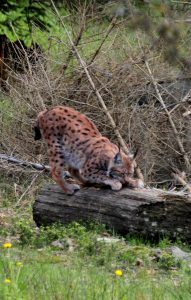After spending their first month mostly in dens, kittens start to explore the environment and play outside of the den. Sometime between the first and second month, their mother decides it is time for them to see the world and starts the mobile phase of their growth.

In this phase, they are mostly moving, feeding, and looking for prey. Wandering large distances throughout their mother’s home range might make the kittens familiar with the concepts of refuge places, water resources, and prey distribution. Teaching hunting skills and coming into contact with prey is an important part of their development, so mothers hunt with their young to teach them proper techniques. Kittens learn this through observation and practice. They are very active, curious, and skilled at climbing trees, using their sharp claws.

Lynx playing, author: Miha Krofel
Research in the Jura Mountains showed that after four months, kittens sometimes become aggressive to each other at the kill site. Consequently, they did not feed together anymore, instead of coming to the kill site one by one. After this, they didn’t fight or become more aggressive to each other, but the order of feeding was very well known. From January onwards it was mostly the mother who ate first.
When the new mating season starts, the family mostly breaks up. After the cubs leave their mother, siblings may travel and hunt together for several months. When hunting together, one animal chases the prey into the direction of the other. After that period together, the siblings separate. Male lynxes travel longer distances than females, who generally stay close to their mother.
INTERESTING: In 2007, researchers in Slovenia put a collar on a young female called Dina, whose territory was around Snežnik mountain. That year she had 2 cubs and was recorded at camera traps with both of them – Puhi and Burja. In 2019, Croatian and Slovenian researchers realized that a female named Miška with territory in Gorski Kotar, Croatia, 50 km away from Dina’s territory in Slovenia was actually one of her offspring – Burja!
